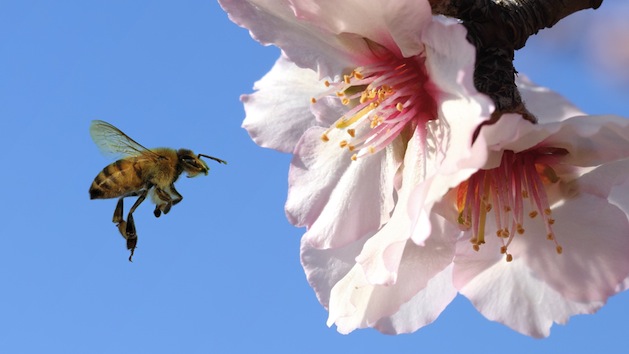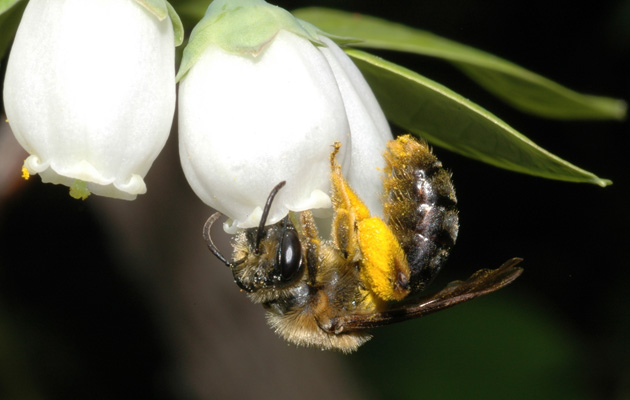
<a href="http://www.shutterstock.com/pic-94126963/stock-photo-a-dead-honey-bee-showing-many-details-of-body-legs-and-mouth-parts-apis-mellifera.html?src=XPChrYDiQ6Kw2ZwLaid6eQ-1-3" target="_blank">Armando Frazao</a>/Shutterstock
It’s a hard-knock life, scouring the landscape for pollen to sustain a beehive. Alight upon the wrong field, and you might encounter fungicides, increasingly used on corn and soybean crops, and shown to harm honeybees at tiny levels. Get hauled in to pollinate California’s vast almond groves, as 60 percent of US honeybees do, and you’ll likely make contact with a group of chemicals called adjuvants—allegedly “inert” pesticide additives that have emerged as a prime suspect for a large bee die-off during this year’s almond bloom.
The hardest-to-avoid menace of all might be the neonicotinoid class of pesticides, widely used not only on big Midwestern crops like corn and soybeans but also on cotton, sorghum, sugar beets, apples, cherries, peaches, oranges, berries, leafy greens, tomatoes, and potatoes. They’re even common in yard and landscaping products. I’ve written before about the growing weight of science linking these lucrative pesticides, marketed by European agrichemical giants Bayer and Syngenta, to declining bee health, including the annual die-offs known as colony collapse disorder, which began in the winter of 2005-06.
And now, a new Harvard study fingers neonics as the key driver of colony collapse disorder. The experiment couldn’t have been simpler. Working with nearby beekeepers, Harvard researcher Chensheng Lu and his team treated 12 colonies with tiny levels of neonics and kept six control hives free of the popular chemicals. All 18 hives made it through summer without any apparent trouble. Come winter, though, the bees in six of the treated hives vanished, leaving behind empty colonies—the classic behavior of colony collapse disorder. None of the six control hives experienced a CCD-style disappearing act, although one did succumb to a common-to-bees gut pathogen called nosema.
Other studies have shown negative “sublethal” impacts of neonics on bees—that is, that the chemicals harm bees in subtle ways at doses too low to kill them outright. For example, this 2012 Science paper found that tiny amounts of the chemicals significantly affects bees’ ability to find their way back to their hives—”at levels that could put a colony at risk of collapse.” Another 2012 study, also published in Science, found that bumblebees exposed to “field-realistic levels” of a neonicotinoid called imidacloprid exhibited a severely diminished capacity to produce new queens. What makes the new Harvard study remarkable is that it actually simulated colony collapse disorder—neonic-treated bees suddenly abandoned hives that had been healthy all summer, while untreated bees hung around and repopulated their hives.
In the paper, the authors call the spectacle of abandoned hives “striking and perplexing” because “honeybees normally do not abandon their hives during the winter.” More research is needed to identify the mechanism by which neonic pesticides trigger the evacuations, they write, but the results point to “impairment of honeybee neurological functions, specifically memory, cognition, or behavior, as the results from the chronic sublethal neonicotinoid exposure.”
Lu told me he thinks that with this study, coming on the heels of a similar one he published in 2012, the CCD mystery has been solved.
For its part, the pesticide industry is doing its best to shroud the phenomenon in uncertainty, promoting a “multifactorial” explanation that points the finger at mites, viruses, and “many other factors, but not…the use of insecticides,” as neonic producer Bayer puts it in its “Honey Bee Health” pamphlet. As for Lu’s study, Bayer is dismissive. In a response published on the trade website Ag Professional, Bayer accused Lu of overdosing the bees in his study:
Feeding honey bees levels of neonicotinoids greater than 10 times what they would normally encounter is more than unrealistic—it is deceptive and represents a disservice to genuine scientific investigation related to honey bee health.
In an email, Lu disputed this attack. He noted that the dose used, 0.74 micrograms per bee per day over 13 weeks, is actually quite tiny—by contrast, a grain of table salt weighs 64,800 micrograms. The level used in the study is also well below what scientists call the median lethal dose (LCD50) for neonics—that is, the dose required to kill half the members of a tested population. Lu stressed that the treated bees showed no ill effects during the 13 weeks of the feeding—it was only well after exposure to the pesticides, during the winter, that they fled their hives.
Bayer also took issue with the length of the exposure, arguing that it went on too long. “Given the artificially high levels tested over 13 consecutive weeks, the colony failure rates observed are completely expected,” the company claimed in its statement. Lu countered that in New England, where he performed the experiment, bees can forage outside from March to September—30 weeks. In other parts of the country, he added, bees can forage for as long as 41 weeks.
For context on Lu’s paper, I contacted Jeff Pettis, a USDA bee researcher who has participated in several papers on the recent decline of honeybee health—including a 2012 study showing that bees exposed to tiny levels of a neonic called imidacloprid were significantly more prone to succumb to the gut pathogen nosema than unexposed bees. Pettis told me that he thought Lu’s study “adds to the list” of studies showing that pesticides pose a significant threat to honeybees. But he’s not ready to declare a smoking gun—Lu’s sample size, 12 treated hives and six controls, is too small, he says, to draw such a conclusion.
Meanwhile, the USDA has released a preliminary report on its nationwide survey asking beekeepers how their hives fared over the winter. The report found that 23.2 percent of hives collapsed—the lowest levels since CCD began in 2005-06, and down from a peak of about 35 percent in the winter of 2007-08. The previous year’s losses clocked in 31 percent. For its part, Bayer declared the report “encouraging news to everyone who cares about bee health.”
Lu isn’t so sure. He notes that the numbers reflect nationwide averages, and might mask significant regional losses. Beekeepers in Ohio, for example, reported winter losses of 50 percent to 80 percent, and their peers in neighboring Pennsylvania suffered heavy losses as well. He plans to continue studying what he believes is a strong link to neonic pesticides. Last year, Europe placed a two-year moratorium on most neonic uses, pending more research on their effect on honeybees. The US Environmental Protection Agency, for its part, is reviewing its registration of the chemicals, and won’t be done until 2016 at the earliest.













